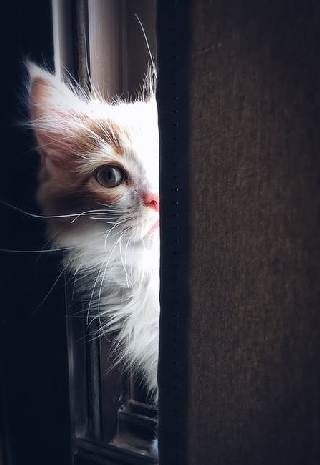Blog
Happy and Healthy Indoor Cat
January 25, 2019

Cats are hunters that have refined their skills over thousands of years into efficient predators. As cat owners we must remember that the feline we share our homes with has the same instinctive drive as their wild cousins. It is our duty to provide an outlet that meets their needs to stalk, hunt and define territory.
Providing environmental enrichment for our feline friends can prevent boredom, giving them an opportunity to explore, hunt and define territory as their innate behavior tells them to do.
First, we must look at the behavior of domestic cats' wild cousins and define their needs and develop solutions suited for a home setting.
Safety and Security
In the wild, cats will wander over a large area. They mark their territory by scent rubbing, scratching and elimination. They strategically choose sleeping areas based on safety, choosing locations away from the scent of food that would attract predators and with territorial views.
In the home setting, if the cat has a cat tree with a sleeping spot, place it in a central location or with a view of multiple rooms. Placing a bed on top of a shelf will provide a vantage point and encourage the use of vertical space to define sleeping locations.
Scratching Surfaces
Cats scratch to mark territory, sharpen claws and stretch their muscles. To train your cat to use a scratching post, reward with treats and praise. Many cats can be encouraged to use a scratching post by putting catnip, treats or toys near the post. Scratching furniture should be sturdy and made of materials that cat prefer, cardboard, carpet, sisal, or wood. Place scratching furniture near sleeping spots, next to doorways or furniture where your cat likes to stretch.
Play and Predatory Behavior
Studies have found that wild and feral cats spend approximately six hours a day exploring their environment and hunting for food. The typical house cat is presented with a bowl of food in the same place every day, available 24/7, without the need to hunt which could certainly cause boredom.
Indoor cats don't have to catch dinner but they still have the instinct to hunt. Creating a stimulating search for food is a great way to fight boredom while fulfilling instinctual drives. An inexpensive way to stimulate hunting instincts is to take each cat's daily rations and divide it up into 8-10 portions. Use small dishes and place the portions throughout the house, varying the placement daily. You can also use interactive toys, such as the PetSafe SlimCat, that allow kibble to come out encouraging activity.
Exploration
In nature, a cat's territory is constantly changing; plants grow, seasons change and other animals cross through providing scents and stimuli. Providing a dynamic environment can encourage cats to explore and interact with their surroundings. Small changes like rearranging a piece of furniture to provide a hiding spot can provoke your cat to explore.
Here are some other options to encourage your cat to explore and interact with the environment:
- Fountains with moving water provides an incentive for increased fluid intake. The sound and movement of the water also provides a multi-sensory experience.
- Puzzle toys like the Trixie Fun Board provide the opportunity for play and exploration. A simple way to create a puzzle toy is to cut small holes in a shoe box and place some toys, catnip mice or treats inside, your cat will paw at it trying to get at the toys or treats.
- Using wand toys for interactive play sessions is an ideal way to avoid fingers and ankles from being the objects of an attack and is a great way to get cats moving.
- There are many videos available that provide auditory and visual stimulation in the form of birds, fish or small mammals on-screen.
- Window perches are a comfortable and safe way for cats to observe the outdoors.
- Cat trees and furniture arrangement that encourages vertical exploration create opportunities for cats to climb, balance and jump providing them with a physical and mental workout.
- Cardboard boxes are a favorite that provides a great base for hunting and ambush games.
When creating exploratory enrichment, it is a good idea to rotate the toys and very the stimulation on a regular basis.



